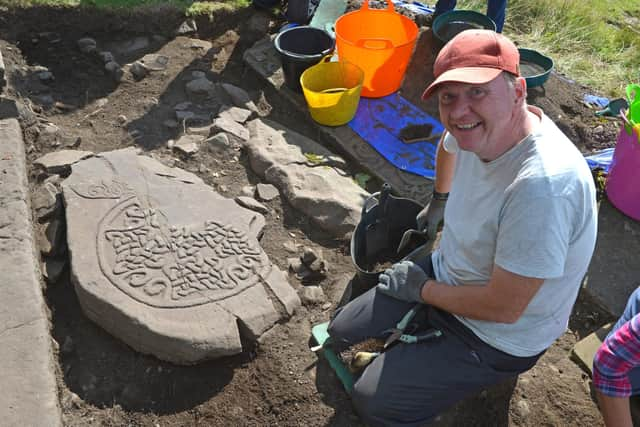Remains of Pictish period cross with bird carvings uncovered in Scottish kirkyard
The broken slab was found in Old Kilmadock Kirkyard near Doune, in Perthshire, and could be up to 1500 years old.
It features a knotwork cross within a circle including long-necked birds' heads above a carved animal thought to depict a boar or wolf that may once have formed part of a hunting scene. Around the edge is an inscription in early medieval ogham.
Advertisement
Hide AdAdvertisement
Hide AdIt has been suggested the bird carvings could be swans or even flamingos – a possible link to previous Roman occupation or trade with Europe.


The surface of the fallen stone was partially revealed in 2019 by volunteers from the Rescuers of Old Kilmadock (ROOK) group during work in the historic kirkyard. Archaeologists returned last month [SEPT] and dug deeper to expose more of the stone.
The chiselled ogham strokes, which have still to be deciphered, are thought to be the first of their kind found in the Forth Valley.
Other fragments found nearby, which also appear to show carvings, may shed further light on the find.
Stirling archaeologist Dr Murray Cook, who led the recent dig, said funds would now have to be raised to lift the stone so that it could be examined in full and experts could assess the cost of its conservation before it can be displayed.
Dr Cook said: "It's already clear that this is a very rare and significant discovery. Perhaps the biggest surprise, however, is the ogham inscription on the edge of the cross slab, which could be a first in this area.
"It's very exciting and we still haven't seen what's on the other side of the slab. There will have to be fundraising for the next phase and we don't yet know what it will cost to repair. I would like to think that it will one day go on display so that everyone can see it."
The carved cross provides further evidence that Old Kilmadock is one of Scotland's most important historic kirkyards, a claim supported by local place names linked to churches spanning centuries.
Advertisement
Hide AdAdvertisement
Hide AdBetween 500 AD and 700 AD, when the cross was first erected, the natural mound overlooking the River Teith may have included a monastery and industry such as metalworking or vellum production for books.
The discovery of the ogham inscription shows monks who operated there were literate.
Ogham characters appear on monumental inscriptions dating back to the fourth century AD. The majority are from Ireland, but nearly a third are found in England, Wales, Scotland and the Isle of Man.
The ancient writing system stayed in use after the establishment of Christianity brought literacy in the form of Latin script written across a flat page.
Dr Kelly Kilpatrick, an historian and Celticist who specialises in epigraphy, will attempt to decipher the newly discovered inscription using photogrammetry to create a 3D model of the stone. She said: "It's a hugely important find. It tells us that in the early medieval period there were literate people here who could read and write, potentially in Latin, but who were also familiar with the ogham alphabet.
"As soon as it was found I took one look and said 'that's ogham'. The inscription is likely to go all the way around, although I can't be certain until the stone is lifted. They tend to say personal names. I can say with reasonable confidence we've got some e's and t's in there."
John Borland, an archaeological surveyor for 36 years with the Royal Commission on the Ancient and Historical Monuments of Scotland (RCAHMS) and Historic Environment Scotland, first recorded the cross in 2019 before he retired. He has remained involved in the project, helping to record it and other carved stone fragments that could be linked to the find.
He said: "In my time I've recorded everything from a mesolithic shell midden from about 6000-8000 BC to WW2 defences around Scapa Flow. This cross is a lovely find and an additional piece of the jigsaw of Scotland's history.
"The stone itself has some unusual features – the form of the cross, the decoration – I've been recording this material for over 30 years and I can't think of another close paralel."
Comments
Want to join the conversation? Please or to comment on this article.